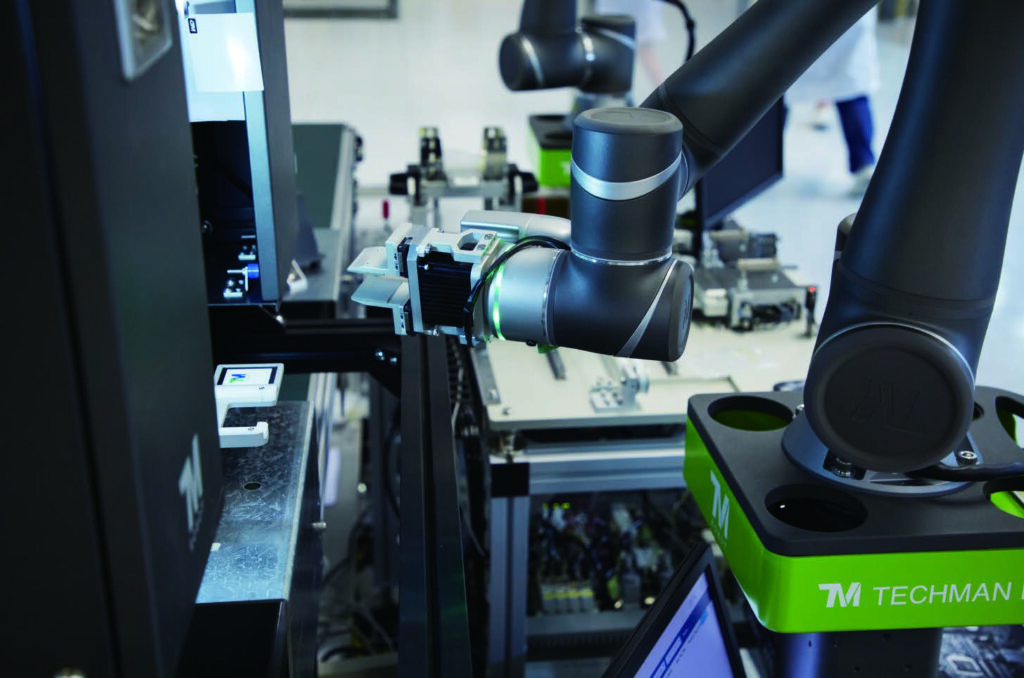Boost Productivity with Expert Cobot Integration
Start working faster, smarter and more efficiently. If you’re facing challenges like labor shortages, production bottlenecks or poor finished product quality, collaborative robots (cobots) offer a flexible and cost-effective automation solution. As your partner in automation, JHFOSTER will guide you from the initial evaluation to seamless integration to long-term support.

What Is a Collaborative Robot?
A collaborative robot, or cobot, is a robot designed to work safely alongside human employees without the need for traditional safety cages. This key difference makes it easier and less costly to deploy cobots in existing manufacturing facilities.
Cobots vs. Traditional Industrial Robots
Unlike traditional robots, which are powerful, fast-moving and require elaborate safety guarding, cobots use advanced technologies that allow them to work collaboratively around humans. They are designed to assist people, not replace them.
learn more about the differences between collaborative and industrial robots.
How Cobots Ensure a Safe Work Environment
Cobots achieve safety through features like power and force limiting, which restrict their movement if they contact a person or object. Many also use advanced safety sensors and cameras to detect human proximity and will slow down or stop to avoid a collision altogether. Even with these safety features, every application must still undergo a risk assessment to ensure safety.
The Benefits of Integrating Cobots into Your Workflow
Integrating cobots frees your skilled workers from repetitive, labor-intensive and time-consuming tasks so they can focus on more complex, higher-value work. This empowers your team and drives significant operational gains.
5 Key Benefits of Using Cobots
1. Increased Productivity: Boost throughput rates and optimize equipment availability.
2. Improved Quality: Achieve consistent, high-precision work with fewer errors.
3. Fast ROI: Low deployment costs and rapid efficiency gains lead to a shorter payback period.
4. Worker Retention: Reduced operator fatigue and fewer repetitive motion injuries lead to greater job satisfaction and improved worker retention.
5. Flexibility: Easily move and reprogram cobots for different tasks as your production needs change.
Discover the key principles of human-robot collaboration and what it means for your team.
Common Cobot Applications: What are Cobots Good At?
Cobots excel at repetitive, precise tasks performed in shared workspaces. Their versatility makes them ideal for a range of applications across many industries.
Cobots are good at:
- Machine Tending: Loading and unloading CNC machines, injection molding equipment and presses.
- Pick and Place: Assembling small parts, sorting items and packaging products.
- Material Handling: Lifting and moving items between workstations.
- Dispensing: Applying sealants, adhesives or paint precisely and consistently.
- Inspection: Performing automated quality checks if equipped with sensors and cameras.
- Palletizing: Stacking and arranging products onto pallets.
Understanding Cobot Technology and Limitations
Cobots are designed to be user friendly, but it’s important to understand how they work, as well as their limitations to ensure the successful outcome of your automation project.
Programming and Control: Are Cobots Easy to Learn?
One of the biggest advantages of cobots is that they are easy to program. Operators don’t need to be coding experts because most cobots are programmed via hand guiding, which involves guiding the arm through the desired motions and waypoints, and user-friendly teach pendants with graphical interfaces that make programming and editing intuitive and fast.
Do Cobots Use AI?
Many modern cobots integrate smart technology. They use advanced sensors and built-in vision systems to detect parts and their orientation. Some newer models incorporate AI and machine learning so they may learn from their experience and improve performance, further increasing efficiency and accuracy. This opens the door for applications that involve more advanced pattern recognition, such as inspection.
What are the Limitations of Cobots?
While they are safer around workers, easier to program, very precise and versatile, cobots do have certain limitations. When compared to traditional industrial robots, cobots typically offer slower speeds and less payload capacity, so applications that demand high volumes or heavy lifting may be better served with a traditional industrial robot.
Your Cobot Integration Journey with JHFOSTER
At JHFOSTER we are your partner throughout the entire automation project, ensuring you get the right solution for your application. Our process follows four key steps: Evaluate. Design. Integrate. Support.
Step 1: Evaluating Your Needs
Not sure where to start? Our robotics specialists will work with you to identify the best opportunities for cobot automation in your facility, ensuring you will invest where it will have the greatest impact.
Step 2: Planning Your Investment: How Much Do Cobots Cost?
The cost of a cobot depends on factors like payload, reach and required end-of-arm tooling. While the initial investment is often lower than that of a traditional industrial robot project, the real value is in the total cost of ownership and rapid ROI. We provide clear, detailed quotes to help you make an informed decision. Use our free robotics savings calculator to help estimate your ROI.
Step 3: Seamless Installation and Integration
Because cobots don’t typically require infrastructure changes like safety caging, installation and integration are faster and less disruptive to your operations. Our team handles the entire process to get you up and running efficiently.
Step 4: Long-Term Support and Reliability
Cobots are built for industrial environments and a long service life. With proper application and maintenance, your cobot will be a reliable, long-term asset. JHFOSTER provides comprehensive service and support to keep your systems running at peak performance.
Start Your Automation Journey Today
Ready to see how a cobot can boost productivity and empower your team? Partner with JHFOSTER to get a tailored automation solution that delivers the results you’re looking for. Contact us today to schedule a consultation with a robotics expert.
